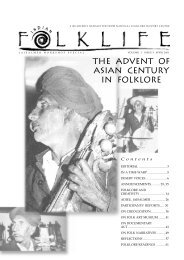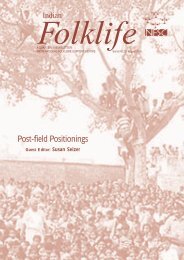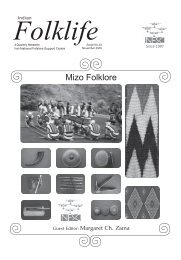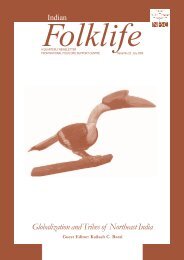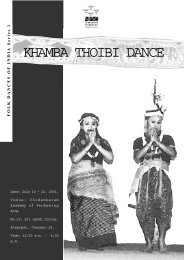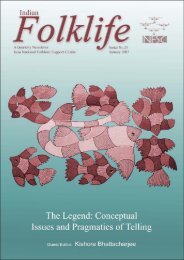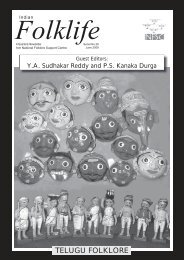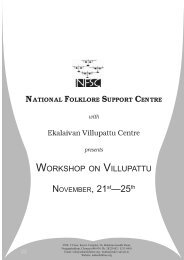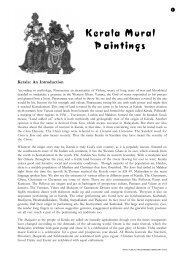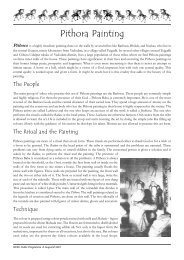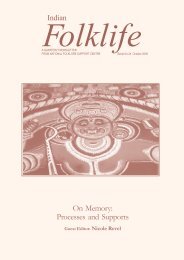Bamboo Flowering in the North-East - Wiki - National Folklore ...
Bamboo Flowering in the North-East - Wiki - National Folklore ...
Bamboo Flowering in the North-East - Wiki - National Folklore ...
You also want an ePaper? Increase the reach of your titles
YUMPU automatically turns print PDFs into web optimized ePapers that Google loves.
The k<strong>in</strong>ship system is one of<strong>the</strong> oldest and most importantelements <strong>in</strong> <strong>the</strong> study of socialorganisation. It <strong>in</strong>cludes sociallyrecognised relationships based ongenealogical ties. These ties orbonds are of three k<strong>in</strong>ds: relationof aff<strong>in</strong>ity (relation betweenspouses), relation of consangu<strong>in</strong>ity(relation between sibl<strong>in</strong>gs), andrelation of descent (relationbetween parent and child). Theprimitive and irreducible characterof <strong>the</strong> basic unit of k<strong>in</strong>ship isactually a direct result of <strong>the</strong>universal presence of <strong>in</strong>cest taboo.(Levi-Strauss, 1973: 46). In humansociety, a man must obta<strong>in</strong> a womanfrom ano<strong>the</strong>r man, who gives hima daughter or sister. Thus, <strong>in</strong> ak<strong>in</strong>ship structure, a k<strong>in</strong>d of role isassociated with his or her status.(Levi-Strauss: ibid). Each person isreckoned by a particular term andhas a particular place <strong>in</strong> <strong>the</strong> k<strong>in</strong>shipstructure. And each one has to docerta<strong>in</strong> duties or obligations to <strong>the</strong>related members of that society.This study tries to understand <strong>the</strong>role and <strong>the</strong> nature of relationshipbetween <strong>the</strong> primary k<strong>in</strong>s 1 such ashusband-wife and bro<strong>the</strong>r-sister, <strong>in</strong>one of <strong>the</strong> Scheduled Tribalcommunities of Kerala, <strong>the</strong>Path<strong>in</strong>aicken.<strong>Folklore</strong> <strong>in</strong> any society reflects <strong>the</strong>way of life of <strong>the</strong> people <strong>in</strong> thatsociety. “Tribal ways of life lie <strong>in</strong><strong>the</strong> state of verbal communicationand here, <strong>the</strong> folklore reflects <strong>the</strong>irecological and cultural sett<strong>in</strong>g morefaithfully” (Vidhyarthi, 1976: 311).The folklore of tribal people reflects<strong>the</strong> unwritten record of <strong>the</strong>ir socioculturallife. It expla<strong>in</strong>s people’ssocio-cultural system, values,beliefs and attitude through itsvarious genres viz., riddles,proverbs, legends, myths etc.Myths are often tales deal<strong>in</strong>g with<strong>the</strong> supernatural and expla<strong>in</strong><strong>in</strong>gK<strong>in</strong>ship and Tribal LoreSeetha Kakkoth is Research Officer (Anthropology),Kerala Institute for Research, Tra<strong>in</strong><strong>in</strong>g andDevelopment Studies of Scheduled Castes &Scheduled Tribes (KIRTADS), Chevayur, Kozhikode.Email: ammusagarika@sancharnet.<strong>in</strong>phenomena such as seasonalchange, day and night, life anddeath (Kesseler, 1974: 152). Theyoften have some serious underly<strong>in</strong>gpurpose beyond that of tell<strong>in</strong>g astory (Kirk, 1970: 41). Thus, thisstudy exam<strong>in</strong>es <strong>the</strong> nature of <strong>the</strong>relationship between <strong>the</strong> primaryk<strong>in</strong>s both <strong>in</strong> society as well as <strong>in</strong>mythical life by study<strong>in</strong>g <strong>the</strong> mythof <strong>the</strong> Path<strong>in</strong>aicken community. Itplaces <strong>the</strong> <strong>in</strong>formant as Ego (aperson who is <strong>the</strong> basic po<strong>in</strong>t ofreference) for draw<strong>in</strong>g agenealogical tree, <strong>in</strong>clud<strong>in</strong>g <strong>the</strong>ascend<strong>in</strong>g and descend<strong>in</strong>ggenerations.The Path<strong>in</strong>aicken myth of lunareclipse collected from secondarysources is analysed <strong>in</strong> this study <strong>in</strong>Levi-Straussian terms. Though thismyth might conta<strong>in</strong> several<strong>in</strong>terpretations, this study focusesonly on <strong>the</strong> relationship betweenconsangu<strong>in</strong>eal and <strong>the</strong> aff<strong>in</strong>al k<strong>in</strong>s<strong>in</strong> <strong>the</strong> myth.The Path<strong>in</strong>aicken tribeThe Path<strong>in</strong>aicken is a dim<strong>in</strong>utivetribal community number<strong>in</strong>g 440persons, liv<strong>in</strong>g <strong>in</strong> <strong>the</strong> semideciduousforest areas of NilamburValley, Malappuram district, Kerala.This community is considered to bean offshoot of <strong>the</strong> major tribe calledKattunaicken and is not listedseparately <strong>in</strong> Census records. Theylive <strong>in</strong> settlements and eachsettlement consists of 30-60 people,who are related to each o<strong>the</strong>r ei<strong>the</strong>rthrough marriage or by blood. Eachsettlement has a headman knownas Chemmakkaran, who acts as <strong>the</strong>socio-political head. A nuclearfamily is <strong>the</strong> basic economic unit.The people subsist on foodga<strong>the</strong>r<strong>in</strong>g,hunt<strong>in</strong>g, small-scalehunt<strong>in</strong>g, non-wood forest producecollection, forest labour and wagelabour.K<strong>in</strong> relationship <strong>in</strong> social lifeThe k<strong>in</strong>ship system of <strong>the</strong>Path<strong>in</strong>aicken community allows aman (see Figure-1) to marry hisfa<strong>the</strong>r’s sister’s daughter i.e.,parallel cous<strong>in</strong> (A), mo<strong>the</strong>r’sbro<strong>the</strong>r’s daughter i.e., cross cous<strong>in</strong>(B), bro<strong>the</strong>r’s widow (C), hisdeceased wife’s sister i.e., levirate(D) and marriage by exchange (E).Among <strong>the</strong> Path<strong>in</strong>aicken, <strong>the</strong> samek<strong>in</strong>ship term, Ch<strong>in</strong>nappan, is usedby Ego to denote his fa<strong>the</strong>r’s youngerbro<strong>the</strong>r, mo<strong>the</strong>r’s younger sister’shusband and step-fa<strong>the</strong>r andsimilarly Ch<strong>in</strong>naive is used to denotehis mo<strong>the</strong>r’s younger sister, fa<strong>the</strong>r’syounger bro<strong>the</strong>r’s wife and stepmo<strong>the</strong>r.A man is allowed to havemore than one wife, but a womanis prohibited to marry more thanone man at a time. Marriage tiesare very fragile: a man can deserthis wife if she is a barren andremarry ano<strong>the</strong>r. Frequentdesertions and remarriages arecommon and a k<strong>in</strong>d of serialmonogamy is <strong>the</strong> result. A man orwoman <strong>in</strong> his/her life-time can maketwo or three alliances.The bro<strong>the</strong>r has an important role<strong>in</strong> his sister’s life. He is supposedto look after his sister if she becomea widow or divorcee. He also takescare of his sister’s children if shedies earlier. He takes <strong>the</strong> <strong>in</strong>itiative<strong>in</strong> conduct<strong>in</strong>g <strong>the</strong> marriage of hissister’s son. He also names <strong>the</strong>child of his sister’s son/daughter.In turn, <strong>the</strong> sister plays animportant role <strong>in</strong> <strong>the</strong> life-cycle ritesof her bro<strong>the</strong>r’s daughter. She givesa help<strong>in</strong>g hand to her bro<strong>the</strong>r’sdaughter at <strong>the</strong> time ofmenstruation and conf<strong>in</strong>ement. At<strong>the</strong> rice feed<strong>in</strong>g ceremony, it is <strong>the</strong>sister who first feeds her bro<strong>the</strong>r’sdaughter’s child. A girl at <strong>the</strong> timeof marriage wears <strong>the</strong> new dressgiven by her fa<strong>the</strong>r’s sister. Sevendays after marriage, <strong>the</strong> bride’sfa<strong>the</strong>r visits <strong>the</strong> groom’s house andtakes both of <strong>the</strong>m to <strong>the</strong> bride’snatal home. The couple spends anight <strong>the</strong>re and before leav<strong>in</strong>g, <strong>the</strong>groom puts some money under <strong>the</strong>pillow. This amount belongs to <strong>the</strong>bride’s fa<strong>the</strong>r’s sister.22 INDIAN FOLKLIFE VOLUME 2 ISSUE 3 JANUARY - MARCH 2003



